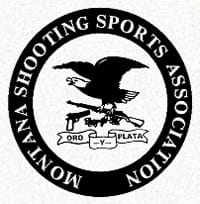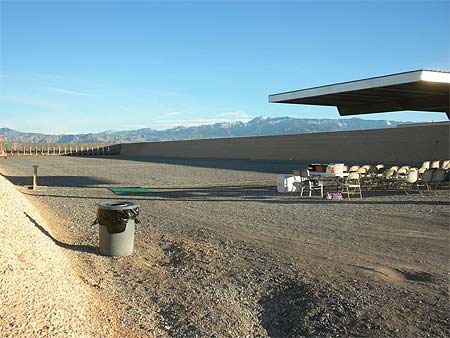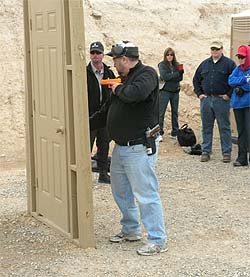Front Sight’s Defensive Handgun Course Review
By Gary Marbut, Montana Shooting Sports Association

Pahrump, Nevada – -(AmmoLand.com)- My 21-year-old son, Ty, and I attended a Four-Day Defensive Handgun course at the Front Sight Firearms Training Institute (FS) near Pahrump, Nevada, about 40 miles west of Las Vegas in southern Nevada.
FS had approached MSSA about an association that might prove beneficial for both. My response was that I couldn’t agree for MSSA to enter into a relationship that might sound like an endorsement without some first-hand experience with FS. I am now ready to make that endorsement of FS. Here are the details of the trip and handgun course.
FS is just over 1,000 miles from my home near Missoula, which could be done in a heroic one-day drive, but is much better done in two days. We couldn’t fly because we had a LOT of difficult-to-take-on-plane gear to haul, plus we took our two dogs. For this class, FS wants students to bring their primary handgun, a backup handgun of the same make and caliber (in case the primary breaks), 800 rounds of new, factory-loaded, jacketed ammunition (no handloads, no commercial reloads, and no lead or plated bullets), plus holster(s), magazines, eye and ear protection, gun cleaning gear, and other accessories.
It was a bit of a scramble finding 1,600 rounds of factory-loaded .45 ACP for Ty and me at a reasonable price. From two sources we ended up with the ammo we needed at about $34/hundred.
The Four-Day Defensive Handgun course is priced on the FS Website at $2,000 per student.
We overnighted after the first travel day in Lehi, Utah, south of Salt Lake City, a tactical stop to allow us to visit the huge Cabella’s store there the next morning. We managed to escape Cabella’s with our wallets pretty much intact. We had reservations at the dog-friendly Best Western in Pahrump and arrived there soon after dark on the second day of travel, having driven by the turnoff to FS about 14 miles before Pahrump on the highway between Las Vegas and Pahrump.
Four-Day Defensive Handgun
The first day of class was Friday and was scheduled to begin at 7 AM. There were several handgun classes, some rifle classes, and maybe others, beginning that Friday morning. Seven to 8 AM was check-in for about 400 students in all classes happening. At check-in we were checked off a list of registered students, given name tags (tape placed on hats mostly), and our guns were checked for condition and serviceability.
The first morning was quite frosty, with a temp of about 28. The lows thereafter were just above or around freezing, and the highs each day were in the upper 50s or lower 60s. On subsequent days without a check-in, class began each day at 8 AM. Most days we were released by 6 PM, except for a night-shooting exercise on Sunday that lasted until about 8:30 PM (chilly).
The instructional day began with a lecture in a large classroom building that can seat about 500 students. There were other lectures in this classroom interspersed throughout the 4-day course, usually in the morning and just after a short lunch period. The first lecture was about Front Sight and its mission. Some lectures thereafter were mandatory (such as “Moral and Ethical Use of Force”) and others were optional (such as “About Front Sight Lifetime Memberships”). Ty and I attended all of the mandatory lectures (which were good), but none of the optional lectures.
The mandatory lectures included:
- Five Levels of Competence
- Color Code of Mental Awareness
- Moral and Ethical Decisions on the Use of Deadly Force
- Use of Deadly Force; Principles of Tactics; Dry Practice Procedures
- Stopping Power.

Front Site Facilities
FS has a considerable array of well-constructed shooting bays. All bays appear to have overhead shade covers about 30 feet square, with folding-chair seating for students under these covers. The bays closest to the classroom have about 15 yards of available shooting distance forward of the covers and seating area. The side dividers on these “pistol” bays are cinderblock walls about 12 feet high and running the full length of the range (including covers). I believe there are four or five of these bays. These bays also include a cinder-block back wall with two doorways, that appears from the outside to be hacienda-style construction. The impact berms are thick and well-groomed piles of what appears to be pea gravel and sand, about 10 feet high, and about four feet thick at the flat top.
Each pistol bay (and the longer bays too) have yardage markings at 3, 5, 7, 10, and 15 yards from the targets. The targets are mounted on electrically-powered turning apparatus so the range master can cause targets to appear for a limited time. Each bay has 20 shooting positions and targets about four feet apart. This arrangement will accommodate up to 20 students firing at once.
There are multiple bays further from the large classroom building that are 75 yards and longer, all divided by gravel berms about 12 feet high, flat on top, and four to six feed wide at the top.
The shooting facilities at FS are obviously designed to facilitate instruction, and are some of the most well-designed and well-maintained shooting/training facilities I have seen in 30 years of visiting shooting ranges from Florida to Washington, and from southern California to New England.
FS is early in a multi-phase build-out. So far, there are no bathrooms. All sanitation is via what they call “brown rooms” – well-maintained porta-potties scattered generously throughout the facilities.
Front Site Course Description
During the range time of the four days, there was a mix of short lectures to individual classes of seated students to explain techniques and exercises, and time on the firing line. Handgun classes are built around 40 students, so half of the students can be on the line at one time. According to instructions the first day, non-shooting students are supposed to be paired off with shooting students as coaches, to critique those on the line about technique. Thus, the class of 40 was broken down into two “relays,” so the range master could summon one designated relay to the firing line at a time.
In practice, this buddy system broke down early from inattention, and students on the line were often unsupervised except by the three dedicated staff members usually on the range. The off-line relay of students were often in the seating area loading magazines or conversing, rather than actively coaching their “partner” on the line. Of the dedicated staff on the range, one was range master and lead instructor, and the others filled in occasionally giving instruction or managing the firing line.
The staff we met were highly competent and good to excellent as instructors. However, with the breakdown of the buddy system, the staff seemed to me to be spread pretty thin to manage 20 students on the firing line. This was the source of Ty’s only really major criticism of the class, because he watched a small handful of students slip through the cracks, some of whom (at most 15% of the class) finished the class pulling most rounds significantly off-target because they hadn’t been carefully coached on trigger control, and an even smaller minority (<10%) who had fairly regular safety violations.
With the first day, we began learning the official “Front Sight” collection of technique. This includes a Weaver stance and platform, a five-step draw (or “presentation” as FS prefers), and range commands readily understandable but somewhat unique to FS (in my experience). Other items of instruction are industry standard, such as universal rules of gun safety. Early in instruction student guns were unloaded before students were allowed to leave the firing line, but as students became more used to rules and competent gun handlers, students were allowed to leave the line with handguns loaded but safely holstered. Staff did watch carefully to insure no students left the bay with loaded firearms.
The targets used are mostly a standard, proprietary FS paper target designed by FS founder Ignatius Piazza. These targets offer a primary thoracic cavity scoring area, and a cranial cavity scoring area, which Piazza scientifically designed based on averages taken from x-rays of thousands of people that Piazza x-rayed while working as a chiropractor. They are on white paper with black lines and gray areas. Standard buff masking tape is used to tape holes in targets between drills or shooters. The targets were changed with sufficient frequency that they didn’t get too tattered.
The on-line practice began with “dry practice,” the term FS prefers for shooting without ammunition. FS has very specific techniques they require for checking the chamber and magazine well of the handgun. This technique appears to be more oriented towards making sure a firearm is loaded than making sure it is unloaded (e.g., checking for a loaded chamber before checking that a loaded magazine is inserted). A good argument can be made that checking to be sure a handgun is loaded also serves to make sure it is unloaded for administrative and safety purposes. Given the strong self defense/combat orientation of FS training, I understand why FS has adopted the standard methodology it has. Hey, it’s their school, although there were some “negligent discharges” by students during the class, but always down range and in a safe direction.
Many of the students used rental guns from the FS “pro shop” that they’d have to pick up each morning before class and turn in each afternoon after class, usually Springfield XDs. This certainly facilitated their travel to and from FS, usually air travel. Students with rental guns would have to show up an hour before class in the mornings to get their daily quota of dry practice homework. Presumably, these students were also buying ammunition from the FS pro shop, which sold for about $68/hundred for .45 ACP.
Students came from all walks of life, with a range of ages from teenagers to able-bodied elderly, and about 1/4 to 1/3 were women. At least a half dozen in our class of 40 had taken this class before. The rest were first-timers.

During the course of the training, there was some more specialized training. One exercise was at the “doors,” a bay with about 30 free-standing doors mounted so instructors could provide training about how to clear a hallway and doorway. Another pair of bays was set up into a house-clearing exercise with shoot and no-shoot photo targets. These bays were constructed to allow nearly 360 degrees of containment, although targets and firing were kept generally within 180. Slow and careful movement though this exercise was encouraged, and the exercise only required about 10 rounds. It was very slow getting 40 students safely through this exercise.
Then there was the night exercise on the third day. That began with another group lecture about how to use lights for shooting at night (the Harries Flashlight Technique), followed by about 50 rounds fired on the range in low-light (i.e. dark) exercises. It was a good beginning exercise, but not enough to make anyone adept really only meant to be an introduction which a person could follow up on by taking more advanced FS classes. Because the night exercise was optional, not all of our class of 40 attended. I was able to shoot in both “relays”, first with a flashlight, and then using my laser. There was plenty of light from other students’ flashlights for me to identify my target, making the laser a distinct advantage. That advantage would have been lost or reduced if I’d been the only shooter on the range.
Quite a bit of attention was paid to clearing malfunctions – standard malfunction drills taught at Front Sight. While all preparation is good, the stress on malfunction clearing seemed a bit excessive to me considering that the majority of students were shooting XDs and Glocks (which so rarely have malfunctions). However, in support of FS teaching, there were some XDs and Glocks that did malfunction during class activities, usually from limp-wristing. And, there was to be a final exam scored both for accurate shooting under time and malfunction drills under time, of which the malfunction clearing was worth around 20%.
Most of the shooting was what FS calls “controlled pairs” – two shots to the thoracic cavity (TC) zone on the FS target. Some shooting was single shots directed to “cranial/ocular cavity” (COC) zone of the FS target, a larger zone than IPSC shooters would call the “Upper A Zone.” These COC shots were for what FS calls “failure to stop” (with two shots to the TC – e.g., body armor), and for hostage rescue. We also did one exercise that simulated multiple assailants, for which they prescribed one shot to each and then any necessary follow-up to the COC. With the exception of about 20 rounds of ammo, all the shooting we did was in controlled pairs or single COC shots.
On Monday, there was a single-elimination, man-on-man competition using all reactive steel targets. This was done to introduce time and stress. The course of fire included for each shooter of the pair a hostage-taker about 6″ square behind the head and shoulder of a hostage target at about five yards, and two head-and-torso steel targets about the size and shape of an IPSC target at 15 yards. A hit on a hostage, taking targets out of order, or finishing behind the other shooter caused elimination of the shooter.
Later that day there was the final exam. This included timed shooting on momentarily-appearing targets from 3, 5, 7, 10 and 15 yards, including timed shots at the COC zone from 3, 5, and 7 yards. It also included five different malfunction drills under short times. Penalty points were assessed for shots outside of the designated scoring zones, and for mistakes in malfunction drills or overtime finish on malfunction drills.
Students were allowed to shoot at static targets if they did not wish to test for “Graduate” or “Distinguished Graduate.” Students opting for static targets were issued “Achievement” certificates.
To earn “Distinguished Graduate” (apparently very coveted), a student could drop no more than 12 points out of a possible of about 155 points. There were only two “DGs” earned in our class of 40, one guy who’d taken the class before, and Ty (yes, proud Dad). Because of a couple of stupid mistakes (such as dropping a magazine that was supposed to go into my pocket on a tactical reload), I finished a few points out of DG and got a “Graduate” certificate.
The trip home was another uneventful two days of driving.
Bottom Line
FS offers many different types of classes. Visit their Website if you want the list. For the Four-Day Defensive Handgun class Ty and I took, the instruction was great and even this old dog learned a bunch – less experienced people learned a LOT. The FS facilities are excellent. With Life Membership, students are allowed to return and take most classes FS offers as often as they want. However, training at FS remains a bit spendy. We went at a good time of year – in summer it will be blazing hot.
(This paragraph from Ty)
Gary Marbut, presidentSomeone interested in FS training should understand that the course they might take is not about sport shooting, or designed to make a person a better Bullseye, IPSC, or Cowboy Action shooter, although the focused trigger time will, of course, be useful. The type of training FS offers is specifically for self-defense and designed to make students better shooters of human targets. This could be a turn-off if you’re thinking of taking someone else along, but could also make the course also extremely valuable. FS teaches ever-evolving, state-of-the-art defensive techniques, and all of the exercises and practice assignments are based on proven defensive tactics and the legal issues associated with self-defense. For example, they prescribe “controlled pairs” because they say that empirical evidence shows that two rounds fired in self-defense tend to stop an attack far more reliably than only one shot, but no more than two because existing legal doctrine would probably consider more than two shots “excessive” and therefore not warranted for self-defense, which could lead to major liability issues.
Now, if Santa would only bring Ty and me Life Memberships, and if FS would just get a transporter installed so Scotty could beam Ty and me and our gear there and home (oh, and a replicator for ammo), I’d become an FS regular.
I do recommend FS for anyone with the time, interest and money to attend and take FS’s training.
(This from Ty) I especially recommend sending new shooters who are interested in defensive shooting, because they are nearly certain to develop a solid defensive shooting platform and an excellent understanding of working with their handgun from scratch (or near-scratch).
Montana Shooting Sports Association
https://www.mtssa.org
author, Gun Laws of Montana
https://www.mtpublish.com
About Montana Shooting Sports Association:
MSSA is the primary political advocate for Montana gun owners. SAF is a national organization headquartered in Bellevue, WA that works nationally to advance the interests of gun owners. Visit: www.mtssa.org
